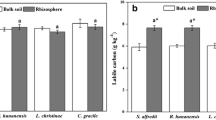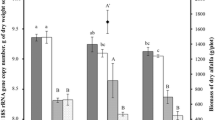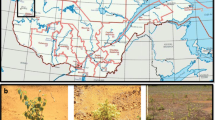Abstract
The diversity and structure of bacterial and actinobacteral diversity and communities were determined in a metallophytic grassland soil from an upland site in northern England. The community profiles were subjected to multivariate analyses using correspondence and cluster analyses. The total bacterial community diversities and structures were not significantly affected by Pb and Zn concentration in the soil. However, the community structure did show changes between winter and summer samples. Raup and Crick analysis indicated that deterministic selection lead to winter profiles exhibiting significant similarity. The actinobacterial community was also unaffected by Pb and Zn concentration. However, seasonal changes were apparent as diversity were significantly lower in winter compared to summer profiles. Moreover, the community structure showed evidence of changes of structure based on the seasonal samples with winter samples showing significant similarity to each other.
Similar content being viewed by others
Abbreviations
- CA:
-
correspondence analysis
- DGGE:
-
denaturing gradient gel electrophoresis
- CI:
-
contamination index
- RCA:
-
Raup and Crick analysis
References
Abaye D.A., Lawlor K., Hirsch P.R., Brookes P.C.: Changes in the microbial community of an arable soil caused by long-term metal contamination. Eur.J.Soil Sci. 56, 93–102 (2005).
Bååth E., Diaz-ravina M., Bakken L.R.: Microbial biomass, community structure and metal tolerance of a naturally Pb-enriched forest soil. Microb.Ecol. 50, 496–505 (2005).
Balabane M., Faivre D., Van Oort F., Dahmani-Muller H.: Mutual effects of soil organic matter dynamics and heavy metals fate in a metallophytic grassland. Environ.Poll. 105, 45–54 (1999).
Bamborough L., Cummings S.P.: The impact of increasing heavy metal stress on the diversity and structure of the bacterial and actinobacterial communities of metallophytic grassland soil. Biol.Fert.Soil 45, 273–280 (2009).
Baxter J., Cummings S.P.: The impact of bioaugmentation on metal cyanide degradation and soil bacteria community structure. Biodegradation 17, 207–217 (2006).
Brodie E., Edwards S., Clipson N.: Soil fungal community structure in a temperate upland grassland soil. FEMS Microbiol.Ecol. 45, 105–114 (2003).
Feris K., Ramsey P., Frazar C., Moore J.N., Gannon J.E., Holbert W.E.: Differences in hyporheic-zone microbial community structure along a heavy-metal contamination gradient. Appl.Environ.Microbiol. 69, 5563–5573 (2003).
Feris K.P., Ramsey P.W., Rillig M., Moore J.N., Gannon J.E., Holbert W.E.: Determining rates of change and evaluating group-level resiliency differences in hyporheic microbial communities in response to fluvial heavy-metal deposition. Appl.Environ. Microbiol. 70, 4756–4765 (2004).
Frey B., Stemmer M., Widmer F., Luster J., Sperisen C.: Microbial activity and community structure of a soil after heavy metal contamination in a model forest ecosystem. Soil Biol.Biochem. 38, 1745–1756 (2006).
Giller K.E., Witter E., Mcgrath S.P.: Toxicity of heavy metals to microorganisms and microbial processes in agricultural soils; a review. Soil Biol.Biochem. 30, 1389–1414 (1998).
Grayston S.J., Griffith G.S., Mawdsley C.D., Campbell C.D., Bardgett R.D.: Accounting for variability in soil microbial communities of temperate upland grassland ecosystems. Soil Biol.Biochem. 33, 533–551 (2001).
Gremion F., Chatzinotas A., Harms H.: Comparative 16S rDNA and 16S rRNA sequence analysis indicates that Actinobacteria might be a dominant part of the metabolically active bacteria in heavy metal-contaminated bulk and rhizosphere soil. Environ. Microbiol. 5, 896–907 (2003).
Griffiths B.S., Bonkowski M., Roy J., Ritz K.: Functional stability, substrate utilisation and biological indicators of soils following environmental impacts. Appl.Soil Ecol. 16, 49–61 (2001).
Griffiths R.I., Whitely A.S., O’Donnell A.G., Bailey M.J.: Influence of depth and sampling time on bacterial community structure in an upland grassland soil. FEMS Microbiol.Ecol. 43, 35–43 (2003).
Griffiths B.S., Hallett P.D., Kuan H.L., Pitkin Y., Aitken M.N.: Biological and physical resilience of soil amended with heavy metal-contaminated sewage sludge. Europ.J.Soil Sci. 56, 197–205 (2005).
Hery M., Nazaret S., Jaffre T., Normand P., Navarro E.: Adaptation to nickel spiking of bacterial communities in neocaledonian soils. Environ.Microbiol. 5, 3–12 (2003).
Heuer H., Krsek M., Baker P., Smalla K., Wellington E.M.H.: Analysis of actinomycete communities by specific amplification of genes encoding 16S rRNA and gel-electrophoretic separation in denaturing gradients. Appl.Environ.Microbiol. 63, 3233–3241 (1997).
Holmes A.J., Bowyer J., Holley M.P., O’Donoghue M., Montgomery M., Gillings M.R.: Diverse, yet-to-be-cultured members of the Rubrobacter subdivision of the Actinobacteria are widespread in Australian arid soils. FEMS Microbiol.Ecol. 33, 111–120 (2000).
Intawongse M., Dean J.R.: Use of the physiologically-based extraction test to assess the oral bioaccessibility of metals in vegetable plants grown in contaminated soil. Environ.Poll. 152, 60–72 (2008).
Joynt J., Bischoff M., Turco R., Konopka A., Nakatsu C.H.: Microbial community analysis of soils contaminated with lead, chromium and petroleum hydrocarbons. Microb.Ecol. 51, 209–219 (2006).
Kennedy N.M., Gleeson D.E., Connolly J., Clipson N.J.W.: Seasonal and management influences on bacterial community structure in an upland grassland soil. FEMS Microbiol.Ecol. 53, 329–337 (2005).
Li Z.J., Xu J.M. Tang C.X., Wu J.J., Muhammad A., Wang H.Z.: Application of 16S rDNA-PCR amplification and DGGE fingerprinting for detection of shift in microbial community diversity in Cu-, Zn-, and Cd-contaminated paddy soils. Chemosphere 62, 1374–1380 (2006).
Lorenz N., Hintemann T., Kramarewa T., Katayama A., Yasuta T., Marschner P., Kandeler E.: Response of microbial activity and microbial community composition in soils to long-term arsenic and cadmium exposure. Soil Biol.Biochem. 38, 1430–1437 (2006).
Mummey D.L., Stahl P.D.: Analysis of soil whole- and inner-microaggregate bacterial communities. Microb.Ecol. 48, 41–50 (2004).
Muyzer G., DE Waal E.C., Uitterlinden A.G.: Profiling of complex microbial populations by denaturing gradient gel electrophoresis analysis of polymerase chain reaction-amplified genes coding for 16S rRNA. Appl.Environ.Microbiol. 59, 695–700 (1993).
Ogino A., Koshikawa H., Nakahara T., Uchiyama H.: Succession of microbial communities during a biostimulation process as evaluated by DGGE and clone library analyses. J.Appl.Microbiol. 91, 625–635 (2001).
Quevauviller P.: Operationally defined extraction procedures for soil and sediment analysis — II. Certified reference materials. Trends Analyt.Chem. 17, 632–642 (1998).
Ramette A.: Multivariate analyses in microbial ecology. FEMS Microbiol.Ecol. 62, 142–160 (2007).
Rowan A.K., Snape J.R., Fearnside D., Barer M.R., Curtis T.P., Head I.M.: Composition and diversity of ammonia-oxidising bacterial communities in wastewater treatment reactors of different design treating identical wastewater. FEMS Microbiol.Ecol. 43, 195–206 (2003).
Sigler W.V., Turco R.F.: The impact of chlorothalonil application on soil bacterial and fungal populations as assessed by denaturing gradient gel electrophoresis. Appl.Soil Ecol. 21, 107–118 (2002).
Author information
Authors and Affiliations
Corresponding author
Rights and permissions
About this article
Cite this article
Bamborough, L., Cummings, S.P. The impact of zinc and lead concentrations and seasonal variation on bacterial and actinobacterial community structure in a metallophytic grassland soil. Folia Microbiol 54, 327–334 (2009). https://doi.org/10.1007/s12223-009-0042-5
Received:
Revised:
Published:
Issue Date:
DOI: https://doi.org/10.1007/s12223-009-0042-5




